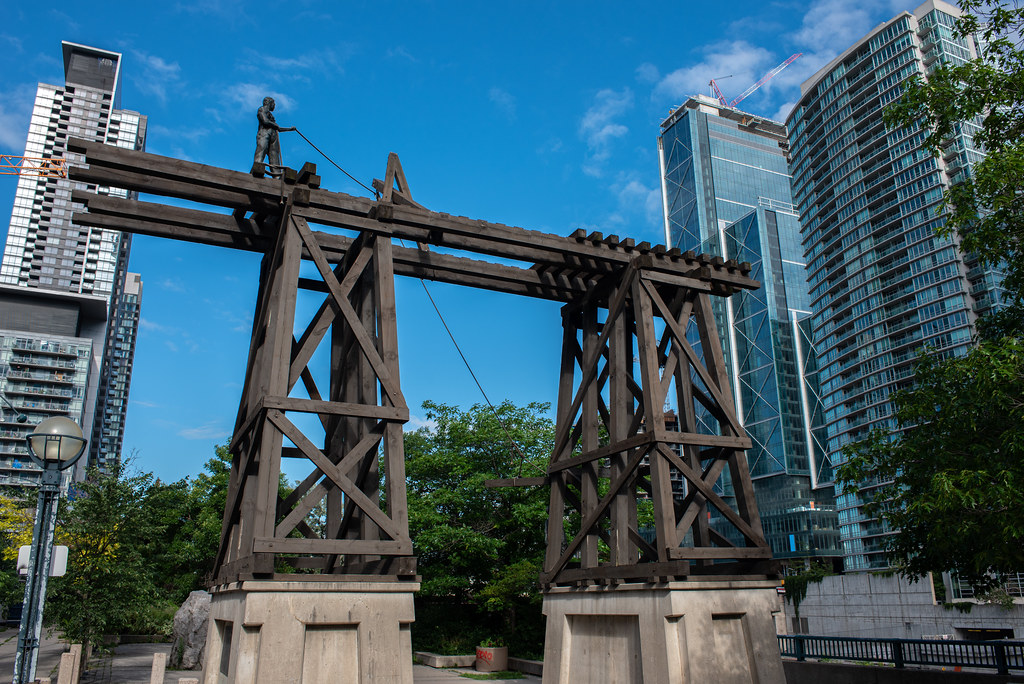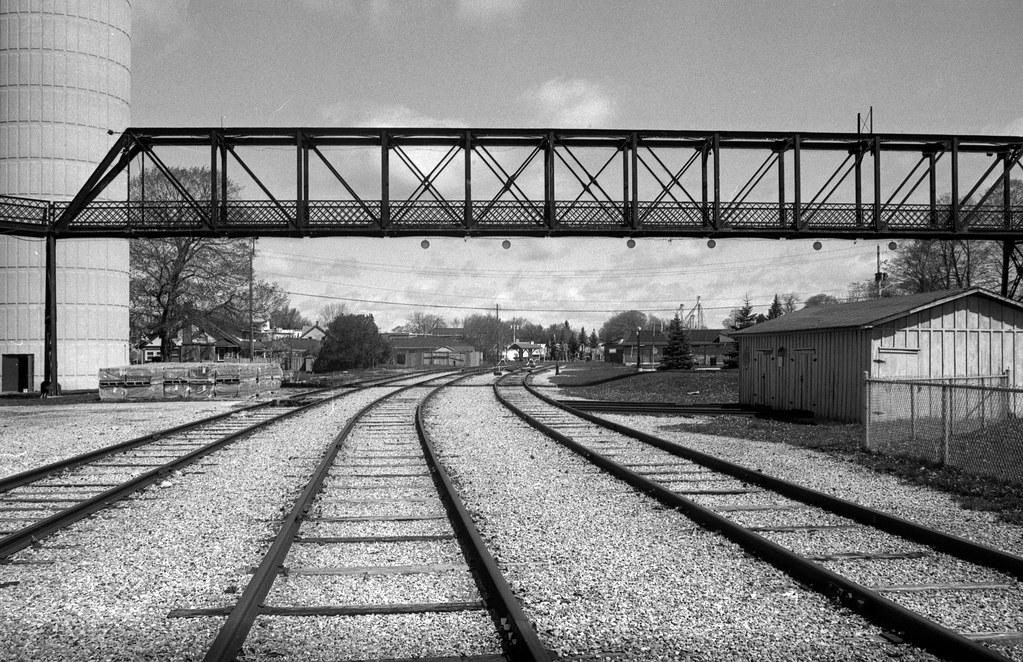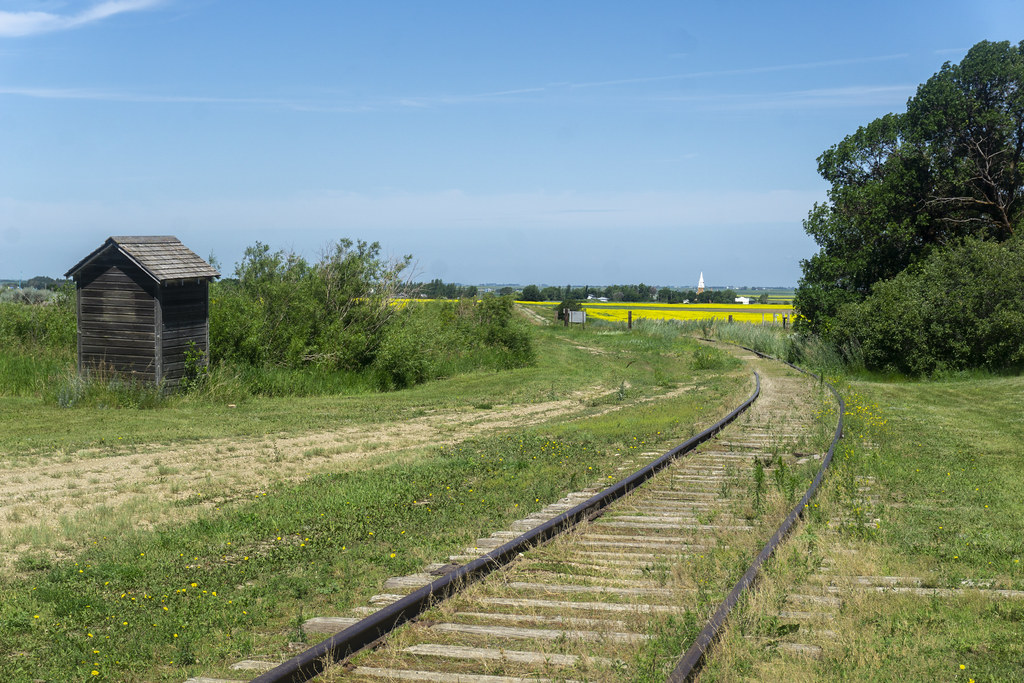In about three decades, the railway in Ontario had grown from a small collection of operators to the principal means of moving people and cargo around the Province and, by extension, Canada. But the one thing that it still lacked was a complete link across the entire length of British North America. While some efforts had been made in 1873, the resulting scandal ousted the MacDonald conservatives, and the new Liberal Government made some efforts to start the construction in 1875. Despite completing 1,000 kilometres of track by the time they were voted out in 1878, not enough had been done. MacDonald returned to power, and rather than see the Government continue to fund the entire network, a new private corporation, the Canadian Pacific Railway, got its charter in 1881.

Nikon D750 – AF-S Nikkor 28-70mm 1:2.8D
Sony a6000 + Sony E PZ 16-50mm 1:3.5-5.6 OSS
Nikon D750 – AF-S Nikkor 28-70mm 1:2.8D
The power of private investment, funds, and further Ottawa’s government support kicked the construction into high gear. While a line running from the western terminus at Port Moody in British Columbia, Winnipeg rushed west to meet it. Thunder Bay headed towards Callendar Station (today Bonfield, Ontario), where a ceremonial first spike marked the official start of the construction. Depending on where the building took place determined the amount of danger posed to the workers. The most dangerous work took place through the surveyed route in the Rocky Mountains, done by immigrant labour. Mainly Chinese who had already faced a great deal of racism at the hands of the Canadian Government in arriving in Canada worked for pennies a day—and often paid with their lives building bridges and digging tunnels. But Canadian Pacific realised that to be an actual transcontinental line, they needed access into southern Ontario, namely the major urban centres of Toronto and Hamilton. Their first step was acquiring through the lease of the entire Canada Central Railway, which included the Brockville & Ottawa line. To do this, they revived a small railway charter, Ontario & Quebec, with mainly Canadian Pacific investors with some minor private investments to support the work. However, they did open up construction on a line running from Perth to Toronto. Southern Ontario proved a significant battleground for railway operators. Grand Trunk paid out a large sum of money to be the top dog in the region but still faced their biggest competitor, Great Western. Great Western would finally start to profit, thanks mainly to strict austerity measures and a great deal of cutting of services. But the wolves were already at the door, and their name was Grand Trunk. Initially, Grand Trunk offered to lease the entire line, but after that proved illegal, they outright purchased the whole network in 1882. The move also netted them the Wellington, Grey & Bruce network. Seeing this, the Government, who was tired of supporting the ageing Toronto, Grey & Bruce line, offered up control to Grand Trunk. Who could not afford to replace the crumbling infrastructure and regauge the entire line from narrow to standard and turned it down? In 1883 the whole Canadian Southern Network landed in a lease to Michigan Central Railway, another Vanderbilt owned network. Ontario & Quebec took the opportunity to secure two more rail networks a year later, gaining 999-year leases on Toronto, Grey & Bruce and Credit Valley, and in 1884 the entire Ontario & Quebec line saw a lease for 999-Years to Canadian Pacific Railway. Canadian Pacific now had access into Toronto and rolled their trains into Union Station. While Grand Trunk would now control whole sections of railways through the Province, not everyone was happy with their service. Grand Trunk did what they wanted and often paid little attention to their customers. Two small operators gained their charters to build alternative lines; in Guelph, the Guelph Junction Railroad aimed to complete a line from the city’s downtown out to the Canadian Pacific (formerly Credit Valley) mainline at the village of Campbellville and turn it over to Canadian Pacific. And a group of investors chartered the Toronto, Hamilton & Buffalo Railway. While Guelph Junction saw completion, strict limits in the Toronto, Hamilton & Buffalo charter proved impossible even to get shovels in the ground.

Sony a6000 – Sony E PZ 16-50mm 1:3.5-5.6 OSS
Nikon FM – AI-S Nikkor 35mm 1:2.8 – Fomapan 100 @ ASA-100 – Rollei Supergrain (1+15) 7:30 @ 20C
Nikon D750 – AF-S Nikkor 28-70mm 1:2.8D
North & North-Western continued to drive north towards Callendar Station, hitting Huntsville by 1885. Still, already the cracks were starting to show as the two companies, though merged, conducted themselves differently, causing a great deal of friction between the two factions. The push west saw the rise of Railway Colonialism, the simple presence of rails forced many Indigenous bands to give up their land, and when they didn’t Indian agents withheld the needed food for the bands. The collapse of the Buffalo hunt began to cause unrest in Saskatchewan that year by Indigenous People over the lack of action by the Government. Between forcing children to attend Residential Schools (a systemic means of removing the cultural identity from Indigenous Peoples) and the continued push by the railroad the fires of rebellion rose among several Indigenous bands. He was returning from Exile, Metis leader Louis Riel. Construction on the Canadian Pacific line hit a fever pitch to get the line extended into Saskatchewan. Not to bring much-needed supplies but rather the Canadian Militia and North-West Mounted Police. The railway allowed the troops to move quickly across Canada, resulting in what history knows as the North-West Rebellion. It also allowed the last spike on the Canadian Pacific line to hit home that same year. However, the first train would not run from Montreal to Port Moody until 1886; it extended the line and the western terminus to Vancouver. While North & North-Western completed their line, Grand Trunk was already waiting for them and in 1888 bought out the entire company gaining their link to the Canadian Pacific line at Callandar Station. While Canadian Pacific had gained some serious inroads into Ontario, Grand Trunk remained the Province’s powerhouse. They operated tens of thousands of rolling stock, running on thousands of kilometres of track and owned acres of properties. One of the biggest innovations completed by Grand Trunk in 1891, the St. Clair Tunnel. Built over the course of a year, the tunnel dug by hand connected Sarnia and Port Huron. The opening of the tunnel removed the need for slow rail ferries. But at Toronto’s Union Station faced a great deal of overcrowding by 1892. Rather than build a new station, they decided to expand the existing one. The plans called for several new platforms, and a proper train shed over three of the tracks. Additionally, a seven-storey office tower in the Romanesque style of red brick and stone. New investors rechartered the defunct Toronto, Hamilton & Buffalo line in 1894. But this time around, they managed to remove several criteria from the charter and started purchasing the incomplete Brantford, Waterloo & Lake Erie line. They realigned the right-of-way extending it to Hamilton and building south, hitting Welland a year later. In 1895, seeing a chance to develop their network, Canadian Southern purchased a majority share with Canadian Pacific securing a minority share. While the line would never be completed, Toronto, Hamilton & Buffalo trains could reach Buffalo and Hamilton using a mix of Canadian Southern and Canadian Pacific tracks.

Nikon D750 – AF-S Nikkor 28-70mm 1:2.8D
Rolleiflex 2.8F – Carl Zeiss Planar 80mm 1:2.8 – Rollei Ortho 25 @ ASA-25 – Kodak D-76 (Stock) 6:00 @ 20C
Sony a6000 – Sony E PZ 16-50mm 1:3.5-5.6 OSS
Grand Trunk opened their Union Station expansion in 1896, but passengers quickly realised that the growth did little to help and only worsened matters. One railway publication described Union Station as one of the most incontinent stations in North America. And their decade long move to gobble up their competition had left them strapped for cash. The board brought on Charles M. Hayes as President to help turn things around. Hayes having a reputation for helping out struggling American railway operators quickly began cutting duplicate lines and uniting all the former operators under one banner. Almost overnight, Great Western, Buffalo & Lake Huron, North & North-Western and Wellington, Grey & Bruce were cut and reporting marks dropped. Canadian Pacific, who for the longest time needed to send their westbound trains above the city and turn them east through Parkdale, opened up a direct line along the Don River from Leaside, allowing for a faster and safer route for their trains coming in from the east and also those heading out in that direction. In Manitoba, two investors Sir William Mackenzie and Sir Donald Mann, took control of the Lake Manitoba Railway & Canal Company began constructing a line from the Canadian Pacific mainline to points north and south. They quickly purchased other lines, and by 1897 Mackenzie and Mann had added a few different charters with plans to expand into Ontario. By 1898, Canadian Pacific seeing a surge in traffic, began the long process of adding a second rail line to their mainline. Mann and MacKenzie rechartered themselves in 1899 to Canadian Northern Railways. By 1900 the only choice for a transcontinental railway was the Canadian Pacific; like Grand Trunk, Canadian Pacific could do as they pleased and charge whatever they liked. Both Canadian Northern and Grand Trunk began making plans for their transcontinental line in direct competition with Canadian Pacific, which would reshape rail in Canada going into the new century.